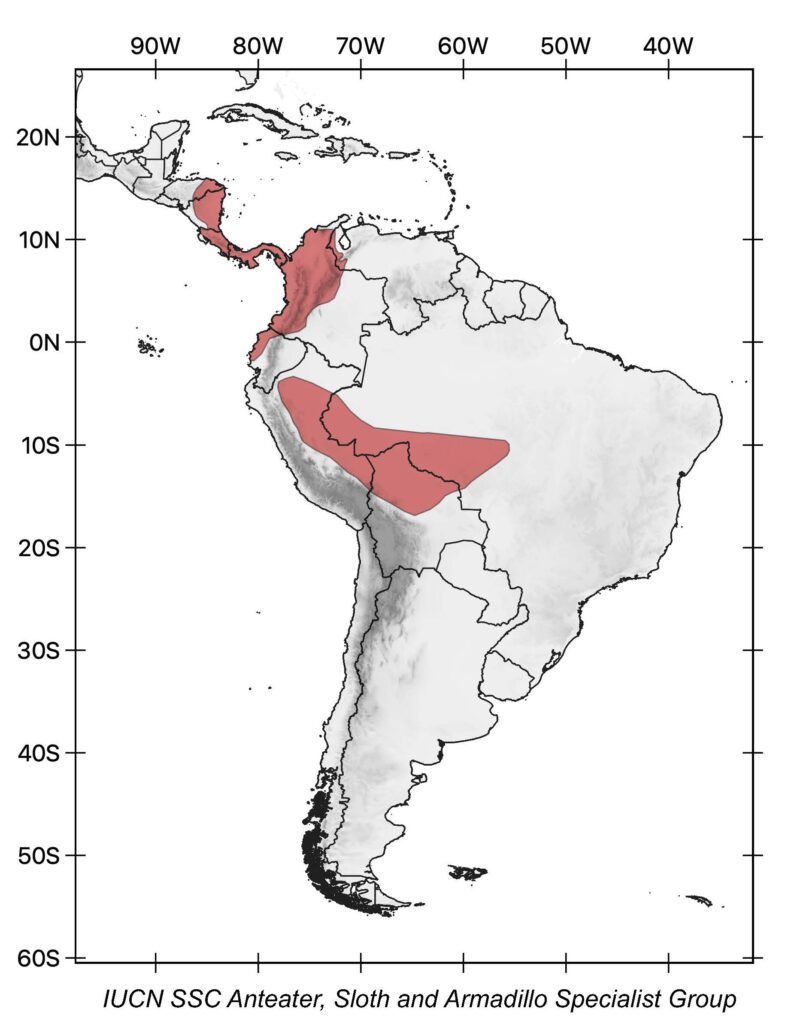Hoffmann’s two-toed sloth
(Choloepus hoffmanni)
other common names
Hoffmann’s two-fingered sloth
Taxonomy
Order: Pilosa
Family: Megalonychidae


description
This sloth has a head-body length of 50–70 cm, a short vestigial tail of 1.4–3 cm, and it weighs 2.7–10 kg. The long fore- and hindlimbs are nearly equal in length. The two foreclaws and the three hindclaws are about 5–6.5 cm long. The body hair ranges from yellowish, blond, buff, or tan, to light brown in adults, but it may appear greenish from the algae that grow on the hairs. The face is usually lighter than the rest of the body, and shorter and finer on cheek and throat than on the neck and shoulder.

range
Choloepus hoffmanni has two disjunct populations. The northern population ranges from southern Honduras to South America, where it can be found west of the Andes from northwestern Venezuela through Colombia to northwestern Ecuador. The southern population is found east of the Andes, from north-central Peru through the southwestern Brazilian Amazon to northern Bolivia. Its range within Brazil is unclear, and further surveys are needed.

diet
The Hoffmann’s two-toed sloth is a generalist herbivore. Its diet consists mainly of leaves, fruits, flower buds, twig tips, young stems, sap of some trees, and apparently some animal matter. In Costa Rica, the species has been observed using 34 different tree species as food.

reproduction
This sloth breeds year-round. Gestation is long, about 340–378 days, and females give birth to a single offspring about every 15 months. The young are usually dependent on their mothers for more than 200 days.

curious facts
Unlike Bradypus sloths, Choloepus species have enlarged caniniform (canine-like) teeth that they may use both in display and physical defense.

Population trend
Decreasing.

HaBITAT and ECOLOGy
Choloepus hoffmanni is largely found in lowland and montane tropical forest. In Central America, it occurs in evergreen and semi-deciduous tropical moist forest, as well as in secondary forest, but it is rare or absent in lowland dry forest. In Costa Rica, it is able to use cocoa plantations (Theobroma cacao) as habitat and frequently ventures into relatively open pastures in search of isolated feeding trees. In Nicaragua, it has been observed in dry grassland with thorny shrubs and trees.
These sloths are arboreal, nocturnal, and rather solitary. They can move as much as 300 m per night. The home range is about 2.5–21.5 hectares and highly variable, especially in males; in cocoa farms of Costa Rica, adult males had home ranges of 1.1–139.5 hectares. The species occurs at densities of 1.05 animals per hectare on Barro Colorado Island, Panama, of 0.3 to 1.5 animals per hectare in the Andean region of Colombia, and 0.2 to 0.83 individuals per hectare in the lowlands of northern Colombia.

threats
Some subpopulations, especially those in Colombia, Central America, Bolivia and Brazil, are declining due to severe habitat degradation and fragmentation. In Honduras this habitat degradation is due to extensive cattle ranching and agricultural crops. In Bolivia it is related to large wildfires, which may kill the animals or affect them indirectly through habitat loss. In Brazil, the few known occurrence records for Choloepus hoffmanni come from the Amazon’s arc of deforestation.
Furthermore, they are hunted by indigenous communities. Wild-caught individuals, especially offspring, are sold as pets to tourists in Colombia. This illegal trade is increasing and represents a cause of concern due to its impact on the wild population.
Individuals inhabiting small forest patches of fragmented forests may fall victims of domestic dogs or other terrestrial predators. In agroforests in Costa Rica, Hoffmann’s two-toed sloths are exposed to pesticides. Electrocution is also an increasing cause of concern in urban areas of Costa Rica.

conservation status
Choloepus hoffmanni is listed as Least Concern in view of its wide distribution, presumed large population, and its occurrence in a number of protected areas. The species is affected by several threats, especially ongoing deforestation, wildfires, hunting, and illegal trade. It is unlikely to be declining fast enough to qualify for listing in a threatened category. However, some subpopulations could potentially be assessed as Near Threatened or Vulnerable. In Brazil, for instance, the species is listed as Near Threatened.